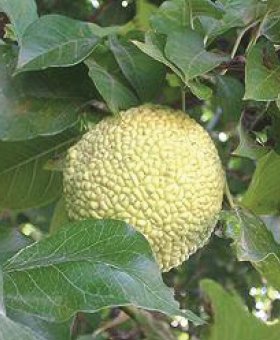Green Horizons
Volume 19, Number 3Fall 2015
OSAGE ORANGE: 'One Tough Tree'
By: DUSTY WALTER | University of Missouri Ag. Experiment Station
By: GENE GARRETT | University of Missouri , Center for Agroforestry
The University of Missouri, Center for Agroforestry prides itself in developing and introducing specialty crops for the family farm. It has conducted successful research and outreach on species like Chinese chestnut, black walnut as an orchard species, long-needled pine species for producing "pine straw", a valuable landscaping mulch, and even gourmet mushrooms. But occasionally, the Center takes on a real challenging species. While some refer to it as one of "Natures Wonders", most landowners see Osage orange as a thorny, very undesirable tree with few redeeming qualities! In spite of this, Osage is actually a very versatile tree. Its utility and potential was realized early by settlers who first came upon it as they made their way westward.
The many names of Osage orange reflect its diversity of uses. The scientific name is Maclura pomifera. However, early in its history the term bois d'arc was used to describe the tree which Native Americans, and specifically members of the Osage Nation, prized for wood to make bows and clubs. This French term has also been stated as "bodark" or "bodarc". "Hedge" is another name often used. This highlights not only its widespread use in the 1930's as the tree of choice for windbreak plantings across the Great Plains states, but also the fact that early settlers would use rows of the tree as a "living fence", capitalizing on the species thorniness and dense branching habit to contain their livestock. And, because it produces a softball-sized green fruit, some will know the tree by the name "hedge apple". So, does the word "orange", in Osage orange, refer to similarities between its fruit and an orange? Possibly, but it may also reflect the fact that the wood is a golden yellow color which may contain unique chemicals of unknown value for wood treatment, pest control, or even medicinal purposes?
 |
While the native range of Osage orange is relatively small, it will grow almost anywhere. Occurring natively in parts of Texas, Oklahoma and Arkansas, it was nonetheless widely planted as a part of the Great Plains Shelterbelt initiative, which was designed to control wind erosion and prevent soil loss. It can now be found growing from Canada to as far south as Florida and Texas and even on the west coast.
While not a typical timber species, Osage does produce multiple products of value. One such product is the hedge post. A fence built with hedge posts will last several generations. Typically, hedge posts can be purchased that range in price from $8 - $25.00/each, depending on size. Historic documentation indicates that fence posts could be harvested every 15 years. Depending on the site (soil and moisture), fence posts most likely can be harvested every 15-40 years. It is also valued as a firewood. Osage has the highest BTU (British Thermal Unit - - a measure of heat produced) output of any North American tree. The propensity of Osage to sprout back after cutting makes it a very renewable farm resource.
Osage, or hedge, also may have other uses. Though science has failed to validate the claims, hedge balls are nonetheless still used by many households to repel insects and spiders. Although the hedge balls are of minimal wildlife value, the tree itself is excellent escape cover from weather extremes. Many a successful pheasant or quail hunt has taken place along hedge rows.
Because of its site adaptability and value of products, Osage offers opportunities for Agroforestry plantings-especially if a method can be developed to grow straight stems. When open-grown, the tree tends to branch heavily and develop poor/crooked form. At the University of Missouri, trials are underway to identify the value of planting Osage at tight spacings, (e.g., 6 X 6 feet) to enhance straightness. If straight stems can be grown, agroforestry plantings with Osage, such as windbreaks and forested riparian buffers, can create effective conservation practices while yielding valuable commercial products.
Perhaps Osage orange, hedge apple, bodark, bois d'arc or whatever name you wish to call it, really is one of "Nature's Wonders"! Maybe it even holds promises that have not yet been realized by the scientific world and can only be realized through extensive chemical analyses and clinical trials. Perhaps such tests might even be inadequate to reveal the secrets of this plants physiology. Who of you out there know of a tree that can be purchased from the Department of Conservation Nursery, loosely re-wrapped in its paper packaging, cast into the edge of a woods, endure the extreme weather conditions of a summer and winter and yet be viable the following spring? Not only viable, but be capable of being planted, surviving and growing vigorously! This is not fiction, it happened!! So in addition to all the other names that have been bestowed upon this species, the authors would like to add one more, it is "one tough tree"!!!